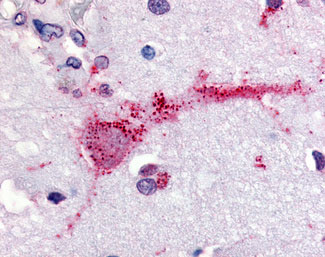GPR3 Antibody (Extracellular Domain)
Rabbit Polyclonal Antibody
- SPECIFICATION
- CITATIONS
- PROTOCOLS
- BACKGROUND

Application
| IHC-P, E |
|---|---|
| Primary Accession | P46089 |
| Reactivity | Human, Rabbit, Monkey, Bovine |
| Host | Rabbit |
| Clonality | Polyclonal |
| Calculated MW | 35kDa |
| Dilution | IHC-P (40 µg/ml) |
| Gene ID | 2827 |
|---|---|
| Other Names | G-protein coupled receptor 3, ACCA orphan receptor, GPR3, ACCA |
| Target/Specificity | Human GPR3. BLAST analysis of the peptide immunogen showed no homology with other human proteins, except TKT (44%). |
| Reconstitution & Storage | Long term: -70°C; Short term: +4°C |
| Precautions | GPR3 Antibody (Extracellular Domain) is for research use only and not for use in diagnostic or therapeutic procedures. |
| Name | GPR3 |
|---|---|
| Synonyms | ACCA |
| Function | Constitutively active G-protein coupled receptor that maintains high 3'-5'-cyclic adenosine monophosphate (cAMP) levels that a plays a role in serveral processes including meiotic arrest in oocytes or neuronal development via activation of numerous intracellular signaling pathways. Acts as an essential activator of thermogenic adipocytes and drives thermogenesis via its intrinsic G(s)- coupling activity without the requirement of a ligand (PubMed:34048700). Has a potential role in modulating a number of brain functions, including behavioral responses to stress (By similarity), amyloid-beta peptide generation in neurons (By similarity). Stimulates neurite outgrowth in cerebellar granular neurons modulated via PKA, ERK, and most strongly PI3K-mediated signaling pathways (By similarity). |
| Cellular Location | Cell membrane; Multi-pass membrane protein. |
| Tissue Location | Expressed predominantly in the central nervous system, and at low levels in the lung, kidney, testis, ovary and eye Highly expressed in regions of the brain implicated in the Alzheimer disease |
| Volume | 50 µl |

Thousands of laboratories across the world have published research that depended on the performance of antibodies from Abcepta to advance their research. Check out links to articles that cite our products in major peer-reviewed journals, organized by research category.
info@abcepta.com, and receive a free "I Love Antibodies" mug.
Provided below are standard protocols that you may find useful for product applications.
Background
Orphan receptor with constitutive G(s) signaling activity that activate cyclic AMP. Has a potential role in modulating a number of brain functions, including behavioral responses to stress (By similarity), amyloid-beta peptide generation in neurons and neurite outgrowth (By similarity). Maintains also meiotic arrest in oocytes (By similarity).
References
Song Z.-H.,et al.Genomics 28:347-349(1995).
Iismaa T.P.,et al.Genomics 24:391-394(1994).
Eggerickx D.,et al.Biochem. J. 309:837-843(1995).
Ota T.,et al.Nat. Genet. 36:40-45(2004).
Gregory S.G.,et al.Nature 441:315-321(2006).
If you have used an Abcepta product and would like to share how it has performed, please click on the "Submit Review" button and provide the requested information. Our staff will examine and post your review and contact you if needed.
If you have any additional inquiries please email technical services at tech@abcepta.com.













 Foundational characteristics of cancer include proliferation, angiogenesis, migration, evasion of apoptosis, and cellular immortality. Find key markers for these cellular processes and antibodies to detect them.
Foundational characteristics of cancer include proliferation, angiogenesis, migration, evasion of apoptosis, and cellular immortality. Find key markers for these cellular processes and antibodies to detect them. The SUMOplot™ Analysis Program predicts and scores sumoylation sites in your protein. SUMOylation is a post-translational modification involved in various cellular processes, such as nuclear-cytosolic transport, transcriptional regulation, apoptosis, protein stability, response to stress, and progression through the cell cycle.
The SUMOplot™ Analysis Program predicts and scores sumoylation sites in your protein. SUMOylation is a post-translational modification involved in various cellular processes, such as nuclear-cytosolic transport, transcriptional regulation, apoptosis, protein stability, response to stress, and progression through the cell cycle. The Autophagy Receptor Motif Plotter predicts and scores autophagy receptor binding sites in your protein. Identifying proteins connected to this pathway is critical to understanding the role of autophagy in physiological as well as pathological processes such as development, differentiation, neurodegenerative diseases, stress, infection, and cancer.
The Autophagy Receptor Motif Plotter predicts and scores autophagy receptor binding sites in your protein. Identifying proteins connected to this pathway is critical to understanding the role of autophagy in physiological as well as pathological processes such as development, differentiation, neurodegenerative diseases, stress, infection, and cancer.


